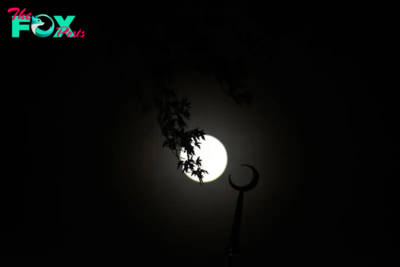Science
Earth from space: High winds paint puzzling ice streaks across the sea in Antarctica
Where is it? The Ronne Ice Shelf, Antarctica
What's in the photo? Wispy strands of ice stretching across a narrow channel of water
Which satellite took the photo? Landsat 8
When was it taken? Nov. 20, 2021
This photo captured streaks of fragile ice stretching across a narrow ocean channel in Antarctica. The rare sight was triggered by a combination of high winds and unusual ocean currents, and it could become more common in the coming years due to human-caused climate change.
The ice streaks stretched across a roughly 3.7-mile-wide (6 kilometers) channel of seawater between the Ronne Ice Shelf — a massive, white ice sheet attached to Antarctica's mainland that frequently births some of the world's biggest icebergs — and a patch of fragmenting sea ice, which appears gray around its edge.
The streaks are made from nilas, a type of super-thin ice less than 4 inches (10 centimeters) thick, according to the National Snow and Ice Data Center (NSIDC). Nilas is normally created when loose ice crystals, known as frazil ice, merge into fragile sheets across a still surface.
However, in this case, high winds created unusual whirlpool currents, or vortices, on the ocean's surface, which stopped sheet ice from forming and forced the nilas ice to gather at the currents' centers before being blown across the water, according to NASA's Earth Observatory.
The high winds also pushed the sea ice away from the Ronne Ice Shelf, giving nilas more space to grow and stretch out.
Related: 12 amazing images of Earth from space

In the image, the nilas ice accumulates along the edge of the sea ice, forming a pale blue band. The color is unusual for this type of ice. Normally, glaciers and sea ice appear blue only when they become so dense that they absorb the longer wavelengths of light, meaning they only reflect the shorter, blue wavelengths.
-

 Science2h ago
Science2h agoHow to See the ‘Beaver’ Supermoon—the last of 2024
-

 Science5d ago
Science5d agoInside Capitol Hill’s Latest UFO Hearings
-

 Science5d ago
Science5d agoYou Won’t Want to Miss the Leonid Meteor Shower. Here’s How and When You Can See It
-

 Science5d ago
Science5d agoHere’s What Trump’s Win Means for NASA
-

 Science1w ago
Science1w agoWhy Risky Wildfire Zones Have Been Increasing Around the World
-

 Science1w ago
Science1w agoIt’s Time to Redefine What a Megafire Is in the Climate Change Era
-

 Science1w ago
Science1w ago4 Astronauts Return to Earth After Being Delayed by Boeing’s Capsule Trouble and Hurricane Milton
-

 Science1w ago
Science1w agoThe Elegance and Awkwardness of NASA’s New Moon Suit, Designed by Axiom and Prada



























